| The Front Page - April 2016 to January 2017
< |















|
|
| |
More Bushong Genealogy
Coming in 2017!
There's still more Bushong genealogy coming!
See you in 2017!
Happy New Year! 
Rick
December 30, 2016
New Photo of John Andrew Bushong
or
Please Don't Cutoff
Great Granddad's Head!
Photographs are still being received and located for the Bushong United Photo Album, and more are being added, here. They come in all conditions, too. Some may have noticed the new photograph of John Andrew Bushong...
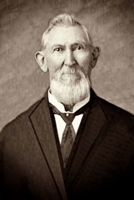
John Andrew Bushong
|
|
|
Part of the pioneering Kentucky Bushong clan, John Andrew was born November 4, 1792 in Montgomery County, Virginia and he died June 26, 1883 in Monroe County, Kentucky. He married twice, once to Feraby White, and following her death in 1858, to Jane D. Pace Hutchens, a widow. Jane died ten years after John, in 1893. Here's John Andrew's funerary record on FindaGrave. John Andrew is a great grandson of the original immigrants, Johann Nicholas Bushong and Magdalena Schaffner Bushong. To those in my generation, he would be a great great great grandfather. Sadly Bushong photographs from this generation are extremely rare, and we're lucky to have this one which is the second one of him in the collection. Unfortunately, this photograph illustrates how fragile and precarious this part of our Bushong heritage really is.
|
 Just look what had become of it. And where's the original? This copy was cut down to just his head. On top of that, it was misidentified, and was listed as Feraby White Bushong and Frederick M. Bushong, (John Andrew's and Feraby's son). The woman is really his second wife, Jane D. Pace, and they can be identified from another photo, (see the photo album), with their daughter-in-law, Alice Stowe Bushong, (Frederick's wife). Just look what had become of it. And where's the original? This copy was cut down to just his head. On top of that, it was misidentified, and was listed as Feraby White Bushong and Frederick M. Bushong, (John Andrew's and Feraby's son). The woman is really his second wife, Jane D. Pace, and they can be identified from another photo, (see the photo album), with their daughter-in-law, Alice Stowe Bushong, (Frederick's wife).
Many of these old photos are one-of-a-kind too. Those made as tintypes, and the glass plate styles, like ambrotype and Daguerreotype, are the only originals, and were the actual "film" that was used in the camera. On the other hand, the Carte de Viste, or CDV, was created from a negative on photographic paper and as many copies as were wanted could be made. So far, of the hundreds of Bushongs and their spouses from this generation, only 19 or 20 photographs have been located. Yet photographic portraiture, was wildly popular around the turn of the 1860s and most everyone had their "likeness" made, at one time or another. Probably more than once. But where are they? Possibly lost, maybe given away, ending up in someone's hands who doesn't remember or even know them.
Here, on the right, is another example, this one is John Andrew's nephew, George W. Bushong, 1828-1908, husband to Catherine Reed. In this copy, part of his head is actually cutoff! After restoration, and actually creating new parts for the missing pieces, this is what it looks like.
|
| |

|
 | |
George W. Bushong, 1828-1908 before and after restoration.
|
|
But then we were fortunate enough to have a descendant submit this photo, which if studied, turns out to be the original that was used to make the copy above, with what was known as a Camera Lucida.
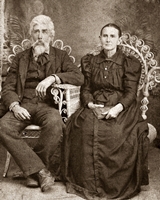 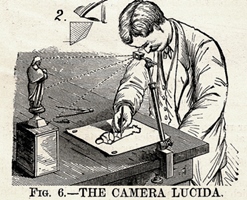
George W. Bushong and Catherine Reed Bushong and a Camera Lucida.
The Camera Lucida uses a rod to support a half-silvered mirror that is tilted at 45 degrees. The image, in front is superimposed on a drawing surface below, and the artist can trace and match it as he draws. They could be used to copy anything and were frequently used to create copies of photographs. There are several other examples of copies made this way in the Bushong United Photo Album. It's easy to see that the original photographs can be much better and more detailed.
But the point is, these pieces of Bushong Heritage are disappearing.
We need to find them and publish them before they are cutup, lost, or just fade away!
Rick
October 26, 2016
A New Ancestry.com Tree
The Bushong United Tree - Limited
 For those interested, in addition to the main Bushong United Tree on RootsWeb, there is now a new Bushong tree. It has been uploaded to Ancestry.com and unlike RootsWeb, it supports and has photos. Though still in progress, I can attest that Ancestry.com creates a nice looking tree, and that working on it has certainly been involving. Named The Bushong United Tree - Limited, it currently features Nicholas' branch. But also listed are Nicholas' siblings and ancestors, so those on Hans John's side, may also find it of interest. Ancestry.com makes it easy for subscribing members to find and to share (copy) other trees and that's what it's for. However, non-subscribing members need an invitation. Either way, we'll know that more Bushong descendants who still think they're French and descended from French Huguenots will have a correct German-Swiss Bushong Tree to remind them of their true heritage - if they want it. For those interested, in addition to the main Bushong United Tree on RootsWeb, there is now a new Bushong tree. It has been uploaded to Ancestry.com and unlike RootsWeb, it supports and has photos. Though still in progress, I can attest that Ancestry.com creates a nice looking tree, and that working on it has certainly been involving. Named The Bushong United Tree - Limited, it currently features Nicholas' branch. But also listed are Nicholas' siblings and ancestors, so those on Hans John's side, may also find it of interest. Ancestry.com makes it easy for subscribing members to find and to share (copy) other trees and that's what it's for. However, non-subscribing members need an invitation. Either way, we'll know that more Bushong descendants who still think they're French and descended from French Huguenots will have a correct German-Swiss Bushong Tree to remind them of their true heritage - if they want it.
 All non-members are welcome and any wishing to see it can simply send me their email address and I'll send an invitation through Ancestry.com
Rick
October 26, 2016
Bushong Digital Library Adds Two Titles!
William Bushong's Civil War Cavalry Raid
and Andrew Bushong's 1759 Banns
I'm pleased to be able to add two more digital books to the Bushong Library.
The first title is a actually a short story, (seven pages), and is The Last Great Stoneman Raid, 1910, written by William H. Bushong, (1845-1931), William who was born in Ohio, served during the Civil War, as a Corporal in Company C of the 12th Ohio Cavalry. Following the Civil War, William married Josephine McDonald, (1846-1928) in Logan County, Ohio, and they had four children.
• Edward H. Bushong
• Nora Ella Bushong (died young)
• Ethel M. Bushong (Gordon)
• Neva Gordon Bushong (Himmelberger)
|
BUSHONG LINEAGE: William H. Bushong/ Jacob Bushong and Rebecca Everingham/ James Bushong and Nancy McCreary/ John Bushong and Jenette Young Summers/ Anthony Andrew Bushong and Catherine Bushong/ Johann Nicholas Bushong and Anna Magdalena Schaffner (the immigrants)/ Hanss John Boschung (III) and Anna Maria Boschung of Switzerland, (immigrated before 1719)/ Hans Boschung (II) and Anna Stocker/ Hans Boschung (I) and Anna Anneler/ Michael Studer-Boschung and Dichti Jaggi.
• Census Records: 1850, (indexed as Bashawn), 1860, (not indexed-scan), 1870, 1880, 1900, 1910, 1920, 1930
• Funerary Record: FindaGrave.
William has written about a Cavalry raid, he and the 12th Ohio Cavalry participated in, that occurred in the closing weeks of the Civil War. It was led by General George Stoneman, (1822–1894) who was a Cavalry officer, in the United States Army. Trained at West Point he graduated in the class of 1846 (same as Stonewall Jackson). During the Civil War, General Stoneman had an inauspicious beginning, being and ineffective part of General Joseph Hooker's 1863 defeat at Chancellorsville. Then in July 1864, Stoneman, under command of General William Tecumseh Sherman, was actually captured by the Confederates, when his cavalry tried to liberate the Yankee prisoners at Andersonville. Exchanged within three months, General Stoneman was given garrison duty in Washington, until his friend, General John M. Schofield intervened and persuaded Secretary of War Stanton and General Ulysses Grant to give him command of a Cavalry Corp. Back in command, General Stoneman successfully executed a raid into Southwest Virginia in December of 1864, and this partially vindicated him.
|
As the winter of 1865 began. General Grant was determined to trap General Lee and what was left of the Army of Virginia, and a plan evolved. General Stoneman, now in Tennessee, was ordered to North Carolina to approach the Virginia railroad lines from the New River and advance toward Lynchburg as quickly and as closely as possible. From there he was to destroy portions of the East Tennessee & Virginia Railroad, the North Carolina Railroad, and the Danville-Greensboro Railroad line, then turn towards Danville, Greensboro and other points such as Salisbury and Charlotte as practical. The intent was to cut off Lee's Army from retreat and prevent them from being resupplied.
On March 21, 1865, General Stoneman rode out of Knoxville, with some 4000 cavalry troops for what turned out to be the longest cavalry raid in the Civil War. From a military point of view, the raid, later known as the Last Great Stoneman Raid, was well executed with near military precision and just a small number of casualties. But to the South, that by this time was reeling and barely able to put up a defense, it was seen as brutal and senseless, and General Stoneman and his reputation struck fear in the hearts of the Southerners in the many areas and towns that his troops raided. Afterwards, General Sherman said that Stoneman’s last raid, together with a handful of other cavalry raids, dealt a fatal blow to the Confederacy. But General Grant wasn't so sure how effective his strategy had been, and wrote in his memoirs, that instead of affecting the outcome of the war, the damage from General Stoneman’s 1865 raid just slowed the postwar recovery in those areas. Grant wasn't alone in his assessment of the raid and even years later General Stoneman was not thought of kindly by the locals who lived where his cavalry had struck.
|
|
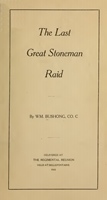
Cover of William's story, (click to enlarge)
|
Jumping ahead a century, those of us old enough, may remember the 1969 rock and roll song, by songwriter Robbie Robertson of "The Band", that mirrors Grant's sentiment in "The Night They Drove Old Dixie Down".
"Virgil Caine is the name, and I served on the Danville train. Till Stoneman's cavalry came and tore up the tracks again"...
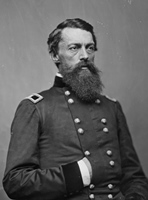
Major General George
Stoneman, 1822-1894
Governor of California 1883-1887 |
|
If you thought the line was something else like, "Till Stonewall's cavalry came..." you're not alone, at least that's what most of us thought. That is unless in 1971, you were a Joan Baez fan. When Joan recorded it, she accidentally changed the line to "Till so much cavalry came". Stepping back, trying to put it all in perspective, maybe the raid can be thought of, as the final nail in the Confederacy's coffin. Still someone had to be the one to actually hammer it in and perhaps that was General Stoneman and his cavalry troops.
Regardless, the surrender of General Lee and his Army meant the initial mission was over, but there was still a final task for General Stoneman and his raiders. The remnants of the Confederate government including, Jefferson Davis, trying to evade capture, were now fleeing south. General Stoneman's Raiders were close and were ordered on April 23, to chase Jefferson Davis to "the ends of the earth." Now in pursuit, the raiders drove down into South Carolina and then Georgia, and though several times they narrowly missed the fugitive president, they weren't the ones to capture him. The raiders however, were ultimately recognized for helping to drive Davis into the waiting hands of Union forces at Irwin, Georgia on May 15th. Still, along the way, the raiders managed to capture a couple of notable Confederates, including Generals Braxton Bragg and Joseph Wheeler. Capturing Wheeler, must have been especially rewarding, as it settled a score, since it was Wheeler's cavalry, that had captured General Stoneman, the year before. But with Jeff Davis now in custody the Raiders were free to return to Nashville, arriving by rail, June 12th. The Last Great Stoneman Raid took just shy of 12 hard-riding weeks.
|
For us, we are just lucky to have Cpl. William Bushong's account of the events and perhaps some of us will be interested to note, that a Bushong was there, "The night they drove old Dixie down".
 To read the PDF of The Last Great Stoneman Raid, 1910, by William H. Bushong, on Bushong United: Click Here
 General Stoneman's Funerary Record: FindaGrave.
The second new digital book for the Bushong Library is Sketch of Early Ecclesiastical Affairs in New Castle, Delaware, and History of Immanuel Church by Thomas Holcomb, 1890. This is an important book for Bushong genealogy, specifically Anthony Andrew Bushong.
BUSHONG LINEAGE: Anthony Andrew Bushong/ Johann Nicholas Bushong and Anna Magdalena Schaffner/ Hanss John Boschung (III) and Anna Maria Boschung of Switzerland, (immigrated before 1719)/ Hans Boschung (II) and Anna Stocker/ Hans Boschung (I) and Anna Anneler/ Michael Studer-Boschung and Dichti Jaggi.
The author, Thomas Holcomb, has written an excellent history of the Immanuel Church in Delaware. It is not just about Delaware but discusses its neighbors to the north, including Pennsylvania, and other locals in Penn's new country. But maybe his transcriptions of the church records, are of greater importance, because Mr. Holcomb transcribed the November 6, 1759 banns for "Anthony Bushong and Cathrine__________", issued by Reverend Aeneas Ross.

Andrew's and Catharine's 1759 banns, transcribed on page 221 (click for full page).
|
|
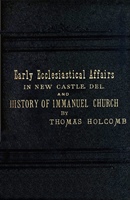
Immanuel Church History cover
|
As many know, a banns is a proclamation made to the parish, that announces the intent to marry. Since it was an English colony, it's probably similar to this banns-form, used in the Church of England, beginning in 1662.
"I (Aeneas Ross) publish the banns of marriage between Anthony Bushong of New Port and Cathrine ________ of ______ . This is the first (or second or third) time of asking. If any of you know cause or just impediment why these two persons should not be joined together in Holy Matrimony, you are to declare it." (Book of Common Prayer 1662)
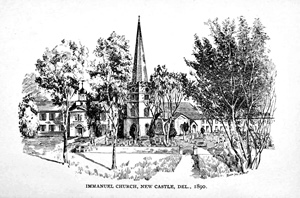
Immanuel Church where Andrew and Catharine issued their banns. Front plate in the book, illustrated 1890. (Click to enlarge)
|
|
Tradition holds that a banns was supposed to be read three times to the parish, however no other banns or a marriage are listed. But from the banns, and Andrew's future civic records with Catharine, we can conclude they were married within a few weeks of its announcement. Possibly Mr. Holcomb did not list the second or third banns as duplicates? They are not listed for anyone. It's seems probable that Rev. Aeneas Ross' original church book has more listed, which brings up an intriguing thought. Since Mr. Holcomb left a blank line after Catharine's name, maybe it just couldn't be read? Maybe in what could have been a dark room lit by candle or gas flame, Mr. Holcomb could not make out her name and drew a line to indicate something was left out? This book doesn't say. But if Reverend Ross' book still exists, there could be a chance that someday Catharine's maiden name will be deciphered. The church book is accounted for, at least until 1890, maybe it still survives, some 125 years later?
But the importance of the banns issued in the name of Anthony Bushong, shouldn't be understated. It connects the two periods of Andrew's life. The Delaware period with Lancaster County, where in 1746, he was first pressed into, then deserted from, Captain Diemer's Pennsylvania Militia. The advertisements calling for Andrew's and once for Anthony's, return to the company, in Ben Franklin's Pennsylvania Gazette verify it. This also proves that amazingly, Andrew sailed back to Europe and returned in the Ship Recovery, on his third transatlantic voyage in 1754!
|
So to complete the sources in this portion of Andrew's genealogy, this book must be cited, along with the 1746 Pennsylvania Gazette advertisements. But if you have more than a passing interest in history, then this book offers more than a genealogical citation. It is an interesting account of both the clergy's and colonist's often difficult lives in the new world.
 |
• The Early Ecclesiastical Affairs in New Castle, Delaware, and History of Immanuel Church on Bushong United Click Here
(opens in a new tab)
• To read Anthony Andrew Bushong the Immigrant Part One: The Pennsylvania Years, Click Here
• To visit the Bushong Digital Library, Click Here
|
An important book and an interesting story - collect them both!
Rick
September 15, 2016
Letter by Mary Ann Bushong
Sister of Peter Valentine Bushong
An 1866 Trip from Indiana to Virginia
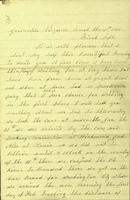
Page one
( click letter to read four pages)
This is an engaging Bushong letter describing an 1866 journey by railroad, boat, and other means, from New Castle, Henry County, Indiana, to Greenville, Augusta County, Virginia, and after their arrival, life in Virginia. It is nicely written in pencil by Mary Ann Bushong, (1827-1897) who it turns out, was traveling with her brother, Peter Valentine Bushong (1832-1913). Click here to read (opens in a new tab).
BUSHONG LINEAGE: Mary Ann Bushong/ Abraham Bushong and Christina Foland/ Peter Bushong and Barbara Wenger/ Hans Philip Bushong and Anna Eva Hergart/ Hans John Bushong and Barbara Bushong (the immigrants)/ Hanss John Boschung (III) and Anna Maria Boschung of Switzerland, (immigrated before 1719)/ Hans Boschung (II) and Anna Stocker/ Hans Boschung (I) and Anna Anneler/ Michael Studer-Boschung and Dichti Jaggi.
In the winter of 1866, Mary Ann and Peter, left Indiana and began their trip to Virginia where they visited family. Finding Mary's letter has helped correct a mistake in the Bushong United Tree. Because, Mary and Peter are buried next to each other in Miller Cemetery, Middletown, Henry County, Indiana, it was assumed they were husband and wife, when in reality they just lived together as brother and sister. No marriage record had ever been found for either of them, and it is now clear they never married. Here's some of the clues.
- In the letter she writes about visiting "our sisters" and a "brother-in-law". This is referring to herself and Peter, and this matches, since they had two sisters in Virginia. They were Carolyn Bushong Strickler and Cathatine Bushong Cox, a widow, resulting in only one brother-in-law, John Henry Strickler who must have been the musician she writes of.
- Mary's age closely matches in all census records, and funerary records, five years older.
- In the 1880, 1900, and 1910, Census, her brother, Peter stated he was single, even after Mary died in 1897, he never stated he was a widow.
- Mary writes of a male friend and hopes he hasn't gotten married.
Interestingly, Mary closes her letter with...
"...do not show this foolish and scribeled letter to any person But excuse my ignorunce[sic]"
Sources:
- Letter: UNC Southern Historical Collection.
- Mary Ann Bushong Census Record: 1850, 1860, Augusta County, Virginia, 1870, and 1880, (not found).
- Mary Ann Bushong Funerary Record: FindaGrave, Miller Cemetery, Middletown, Henry County, Indiana.
- Peter Valentine Bushong Census Record:
1850, 1860, in Augusta County, Virginia, and in Fall Creek, Henry County, Indiana, 1880, 1900, 1910.
- Peter Valentine Bushong Funerary Record: FindaGrave, Miller Cemetery, Middletown, Henry County, Indiana.
- Sophia Minnick (Knupp) Census Record: in Fall Creek Township, Henry, Indiana, 1850, 1870, 1880, 1900, 1910, 1920.
- Sophie Minnick Knupp Funerary Record:FindaGrave, Miller Cemetery, Middletown, Henry County, Indiana.
|
Happy Labor Day!
September 4, 2016
The William Wilhelm Bushong
1837 Ohio Will and Estate
A Grandson of the Immigrants
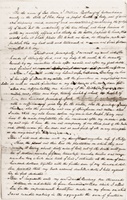
Will, page one.
...to my wife... one History of the Bible (in German)....
From FamilySearch.org, the William Wilhelm Bushong Will and Estate papers are now available on Bushong United. In the past, only bits and pieces had been seen or transcribed of William's estate papers, but now, the full set has been collected, and has its own page on Bushong United. It includes a complete transcription of his three page Will.
BUSHONG LINEAGE: William Wilhelm Bushong/ John Bushong (V) and Elizabeth Sprenkel/ Hans John Bushong (IV) and Barbara Bushong (the immigrants)/ Hanss John Boschung (III) and Anna Maria Boschung of Switzerland, (immigrated before 1719)/ Hans Boschung (II) and Anna Stocker/ Hans Boschung (I) and Anna Anneler/ Michael Studer-Boschung and Dichti Jaggi.
William Wilhelm Bushong was the son of John Bushong (V) and Elizabeth Sprenkel, and was born, December 16 1765, in York County, Pennsylvania. As a boy, he moved with his family, down to Shenandoah County, Virginia. In 1787, while in Virginia, William married Catharine Bartley. However, before 1807, at around forty years old, his family, along with some brothers and their families, migrated to Columbiana County, Ohio. William lived for thirty years in Columbiana, before he died October 26, 1837. William and Catharine had five children that lived to adulthood, and there are quite a few descendants, both living and passed.
It's ironic, but he declared himself in "perfect health" when he wrote his will, but less than six weeks later, he died. To read more, William's Estate Papers can be seen by clicking here, from the Featured Article column or the Articles Page.
Collect them for your archives!
Rick
August 23, 2016
The Bushong Digital Library
Has a New Book
Prof. Rupp's History of Lancaster County
I'm pleased to be able to add a new book to the Bushong United Digital Reference Library...
One of the illustrations, Early Lancaster (restored).
The History of Lancaster County : to which is prefixed a brief sketch of the early history of Pennsylvania by I. Daniel Rupp, Published 1844.
It was some 172 year ago, when Prof. Rupp, wrote this book, that is discussed in the article below. Though it calls the Bushongs French Huguenots, it is still an excellent resource filled with great information about Lancaster, Pennsylvania and its people in the early years.
It will open in a new browser tab and can be read or saved to your computer. The PDF file is 27.9 MB and depending on your download speed will take a moment to open. To visit the Bushong Digital Library, click here.
Rick
August 16, 2016
Interpreting Bushong History
How can you tell what's true?
Click on photos to enlarge. Clicking a PDF will open in a new window.
These days, with the Bushong Family being so thoroughly documented and charted, it's fairly easy to create a family tree of your Bushong ancestors. Face it, with the digital information available, especially from FamilySearch.org, your Bushong line can be tracked back and verified, to family born maybe in the mid to late Eighteenth Century. From there at least with Bushong, there are transcribed church records available. That'll reliably take you back three more generations to the 1731 and 1732 immigrants, Hans and Nicholas Boschung. You don't even need Ancestry.com, since it's all available publicly and ready to be compiled. Then with today's software, it's easy to make a tree and keep track of all those cousins.
But before you just accept the early Bushong genealogy and its history, imagine how much of it was forgotten? Thru the years and generations? So much that eventually little was known about these two immigrants who became Bushongs. It's no wonder that people began adding-on to and embellishing their Bushong ancestors. It's only natural to try and fill the voids but the results were that, more and more assumptions were needed to advance the historical narrative even a little bit.
Through assumptions, look what happens in the case of the immigrant, Nicholas. His son Andrew's life and existence had to just sort of fizzle out in the mid Eighteenth Century, and many thought he had died with no notice of his passing. He just disappeared. So most of us also assumed it must have been another Andrew who arrived in America in 1754, on the Ship Recovery. Then, it couldn't be proved (or even fathomed), that he had actually sailed back to Europe.
Next, consider Hans, who first was called a French Huguenot, and then Jean Beauchamp the French Huguenot. Some even believing him to be of Royal descent. All mistakes and assumptions. Yet the idea of the Beauchamp surname was something that caught on with virtually all American Bushongs. It's OK, I believed it, my parents believed it, and apparently, all the way back to my great great great grandparents, as well. But it was wrong. They were wrong. None of the Colonial Bushong ancestors were French. In fact there's not one single shred of evidence, that they ever lived in France, spoke French or called themselves by French first names, such as Jean or Pierre. There's no evidence that any of the early Boschungs were born anywhere but Germany and Switzerland. But with books, family, and genealogists all saying something different, how's a genealogist supposed to sort through it to get to the truth? Perhaps determining how the French Beauchamp story started would be a good place to begin, and it seems quite likely that this quote from an 1844 book is the source...
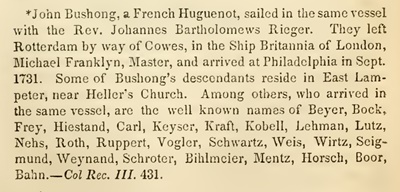 From an 1844 book.
From an 1844 book.
 *John Bushong, a French Huguenot, sailed in the same vessel with the Rev. Johannes Bartholomews Rieger. They left Rotterdam by way of Cowes, in the Ship Britannia of London, Michael Franklyn, Master, and arrived at Philadelphia in Sept. 1731. Some of Bushong's descendants reside in East Lampeter, near Heller's Church. Among others, who arrived in the same vessel, are the well known names of Beyer, Bock, Frey, Hiestand, Carl, Keyser, Kraft, Kobell, Lehman, Lutz, Nehs, Roth, Ruppert, Vogler, Schwartz, Weis, Wirtz, Seigmund, Weynand, Schroter, Bihlmeier, Mentz, Horsch, Boor, Bahn.— Col Rec. III. 431. *John Bushong, a French Huguenot, sailed in the same vessel with the Rev. Johannes Bartholomews Rieger. They left Rotterdam by way of Cowes, in the Ship Britannia of London, Michael Franklyn, Master, and arrived at Philadelphia in Sept. 1731. Some of Bushong's descendants reside in East Lampeter, near Heller's Church. Among others, who arrived in the same vessel, are the well known names of Beyer, Bock, Frey, Hiestand, Carl, Keyser, Kraft, Kobell, Lehman, Lutz, Nehs, Roth, Ruppert, Vogler, Schwartz, Weis, Wirtz, Seigmund, Weynand, Schroter, Bihlmeier, Mentz, Horsch, Boor, Bahn.— Col Rec. III. 431.

|
|
This is from History of Lancaster County : to which is prefixed a brief sketch of the early history of Pennsylvania by I. Daniel Rupp. There is no conceivable way that Prof. Rupp is correct. He does mention in the forward that it took a while to get the book to press, and other people had worked on it. He also added that there were inevitably mistakes, and he was right. But to his credit, he doesn't repeat it and in his final book, the 30,000 Names Book, published 1878, he in no way associated Hans with the French or Huguenots anywhere. So how did he come up with a Frenchman for a German-Swiss? Let's dredge up some Bushong family-lore. There's lore of a letter that says Hans and his family, had to spend seven years in France before immigrating to America. It hasn't been seen in years, and I've never seen it, but maybe they did? Then, please recall that there already was a John Bushong living in Pennsylvania, as early as 1719, he's listed on a property tax list, in Rupp's 30,000 Names Book. If the earlier John Bushong was still alive when Hans immigrated there would be two John Bushongs living very close to each other. Just maybe, Hans was called, maybe even jokingly, "the French John Bushong" or something close, because of his time in France? It would differentiate between the two John Bushongs. What if it was jotted next to his name on some early list and that's what Prof. Rupp saw? But notice Hans isn't called Jean or Beauchamp, since Prof. Rupp had access to the ship's passenger lists.
It should be noted that two of Prof. Rupp's subscribers to the book were John Bushong and Benjamin Bushong, both of East Lampeter, (page 520). These two Bushongs are charted in the Bushong United Tree. Spanning the 1844 publication date, John Bushong, (1794-1869), is enumerated in East Lampeter in the 1840 and 1850 Census records, and Benjamin Bushong (1817-1891), is a nephew, probably living with his father, Jacob in the 1840 Census, but had moved to Leacock Township in the 1850 Census.
|
Then in 1883, Franklin Ellis, and Samuel Evans, joint authors, published the History of Lancaster County, Pennsylvania: with biographical sketches of many of its pioneers and prominent men. They repeated the now forty year old myth and filled in some other Bushong family details.
The Bushong Family.— John Bushong, a French Huguenot, arrived in Philadelphia in September, 1731, and immediately came lo Lancaster County and took up land near what is now Heller's Church. The Bushongs who reside in this township are the descendants of this John Bushong, who had a family of sis boys — John, Philip, Peter, Henry, Jacob, and David — and three girls, — Mary, Barbara, and Elizabeth. In 1737 Mrs. John Bushong died, and Mr. Bushong married a second time. His son Peter emigrated to Virginia, where a prominent branch of this family still resides. Jacob went to what is now Berks County, and the noted bankers of Reading — the Bushongs — are the descendants of Jacob Bushong. David went to Illinois. Philip Bushong inherited his father's estate. John Bushong, son of Philip, is the grandfather of Isaac Bushong, Esq., an influential citizen of this township and county. Amos Bushong, miller of East Lampeter, and Dr. Bushong, New Holland, are of this family. Isaac Bushong, of this township, has in his possession a copy of the will by John Bushong, bearing date June 5, 1749. Page 271.
The Isaac Bushong Esquire that the authors Ellis and Evans refer to, was born in 1822, and he lived in Lancaster County. He would be well aware of Prof. Rupp's 1844 book, In fact, his father, John had bought the book (subscribed) in 1844. Isaac would have known, about the French Huguenot Bushongs, for some forty years. It seems very likely from the detailed description, that Isaac was the informant or source for much of the book's Bushong information. Did he tell the authors about the French Bushongs or did they also get it from Rupp's earlier book? Regardless, it appears Isaac, who was the fifth generation from the immigrants, and maybe even his father, John, had completely forgotten their ancestor's German language and their German Swiss Heritage?
|
|
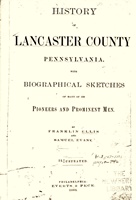
|
Other books continued the French Huguenot story, for example, in 1892, A brief history of Lancaster County, by Israel Smith Clare, Read PDF here. But then, in 1901, the myth grew, when a new embellishment was heaped upon Hans Boschung. It happened in Amon Stapleton's book, Memorials of the Huguenots in America : with special reference to their emigration to Pennsylvania. This was perhaps the most egregious distortion of all - changing his name!
 "Beauchamp--In 1731 arrived Jean Beauchamp, (I) and wife Barbara, the head of the "Bushong" family, now so numerous"... "Beauchamp--In 1731 arrived Jean Beauchamp, (I) and wife Barbara, the head of the "Bushong" family, now so numerous"...
It is, without a doubt, wrong. No Beauchamp arrived in 1731. In fact Rupp's 30,000 Names Book, has no Beauchamp listed at all. None. On top of that, John Bushong clearly signed his name Hans Boschung. The author Mr. Stapleton, must have assumed from one or both books calling John Bushong a French Huguenot, that his surname would have been, shall we say, "more French". The French named John, of course, would be "Jean" but how he came to "Beauchamp", who can guess? Also from either of those books, Stapleton would not have seen that the original spelling was Boschung, which is obviously German. But regardless, because of Stapleton's assumption and embellishment, Jean Beauchamp was created.

1901 Stapleton starts Beauchamp Myth
Read PDF (page 98).
|
|
From there, the Jean Beauchamp myth, was latched onto by family and period genealogists, including Mary Feller Wicks, who as early as the 1920s was calling the family Beauchamp. She even wrote a poem about Beauchamp and Bushong. Then around 1928, Mrs. Wickes added another layer of misinformation to the family lore, with her "Barbara Foltz de Hageneau" and that reinforced the Jean Beauchamp name since Foltz's real husband, was Jean Buchain, of Strasbourg, France. Yet nowhere was there any additional evidence, past the few original documents, involving Hans Boschung or John Bushong. Apparently, sometime before Twentieth Century, the newer generations of Bushong descendants had completely forgotten their family's native German language and Swiss heritage. This, in spite of German being spoken and read for at least the first three generations. There is ample evidence of their German tongue in Wills written completely in German, as well as the German books and Bibles handed down in the Wills. And of course there are the tombstones written in German. But there was never a single mention of or written word in French. Not one.
Nevertheless, in the era of digital communication and online research, Jean Beauchamp spread like a virus to virtually all the Hans Bushong family trees. Now the majority of Hans' online trees, are using all of it or select pieces of it. For example, the bulk of genealogists have kept the France portion of the story, sometimes saying Strasbourg, others Alsace, Lorraine. And of course the French first name of Jean, Some include Beauchamp with the real surnames, (just covering their bases). Others have even added the French first name of Pierre to some ancestors. And of course for Barbara, virtually all have kept the Foltz de Hagenau part. You have to admit, "Barbara Foltz de Hageneau" has a nice ring to it, but for the record, Barbara's maiden name is unknown. Finally, some, fully embracing their faux "French Heritage" have even gone so far as to add a fully French Bushong coat of arms to represent their German-Swiss Bushong ancestors.
|
Still, over the years, a few began to doubt the "French Bushongs". The late Edward M. Bushong, a charter member of the Bushong Bulletin, and for a while its treasurer, eventually came to believe it was completely wrong. He felt so strongly, that he published, in October 1984, A Position Paper to repudiate some claims that the original name of the people named Bushong, in the United States, who descended from Hans Boschung, the Immigrant, was Beauchamp. Seven full type written pages, it was mailed out with one of the first Bushong Bulletins. He too had grown up with Jean Beauchamp as an ancestor, only to realize he never existed. But not everyone was able to read his paper and little changed.
|
As late as 2009 books were being published calling the Bushongs descendants of the French Beauchamp. Take for example three books (all in the Bushong United Digital Library), written by Adam Boyd whose Bushong ancestry begins with a grandmother. Adam's father was a Time Magazine editor, and talent for writing and publishing must run in the family because his books are well written, thoroughly documented, and have many beautiful photographs. First published in 2005, Adam, however, just accepted the myths and his books state Hans Boschung was Jean Beauchamp.
Yet it's interesting that in Adam's second book, published in 2007, he discusses in the foreword, that it was written, mainly to add complete and proper sources that might have been missed in 2005. And he does. He adds many references and sources. But in the Bushong chapter, he's still descended from Jean Beauchamp, only this time, with his zeal for accuracy and sources, he doesn't actually say Bushong are descended from Beauchamp. This time he quotes another book. It is Gilbert Cope's, Historic Homes and Institutions and Genealogical and Personal Memoirs of Chester and Delaware Counties, Pennsylvania, Published in 1904, (pages 540-541). The author, Mr. Cope had obviously read Stapleton's 1901 book, and he continued the myth. Other inaccuracies in Cope's book, immediately begin to bring this source's accuracy into question when, for one, it incorrectly states Hans probably married in America. Adam points out this error, since it is clear Hans immigrated to America with a wife. But attributing through a quote is definitely a better approach than flat out saying they were French Beauchamps. It let's the reader judge the source for themselves. However in his 2009 book, Adam fell back and again repeated the "French Huguenot named Jean Beauchamp" statement and an otherwise well-sourced family history succumbed to the century-old myth.
And keeping that myth has consequences too. Genealogists and historians end up at a dead-end in their tree. It's dead-ended with Jean Beauchamp, of France, because he never existed. A fabricated relative, who can't be charted since he's not related to anyone.
|
|

|
Then consider Andrew Bushong, who arrived in America with his father, Johann Nicholas Boschung and family in 1732 and settled in Lancaster. Thousands of descendants can call him an ancestor, but one event casts a huge shadow on this relationship. Andrew Bushon also arrived in America on the Ship Recovery, in 1754, in Delaware and started a family there. Some genealogist, without evidence, connected their lines to Lancaster Andrew, and in this case they were right. But without evidence, Andrew arriving in America twice, should have been a glaring discrepancy. In 1989, when I published A Branch in the Bushong Family Tree, I too felt Nicholas and Lancaster Andrew were the predecessors of this line, yet I had to stop at Delaware Andrew. Then in 1999 Damon Hostetler, wrote and published Marryin-In II. Damon's Bushong lineage, like Adam Boyd's, also begins with a grandmother. His book is an ambitious undertaking, that covers four different families, Bushong, Ransom, Day, and Clover. With its appendix and indexes the book has over 400 pages and also an abundance of photocopied, but screened photographs and documents. It includes some 46 pages of what is surely every communication or form filled out about George Bushong's, (1788-1880) War of 1812 pension. Though Damon discusses Lancaster Andrew, lacking evidence, he correctly (for the time) differentiates him from Delaware Andrew, with whom he starts his line.
|
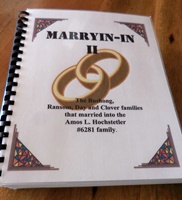
Damon Hostetler's 1999 book, Marrying-In II
(not in digital format), |
|
However, in 2013, it was proven that Delaware and Lancaster Andrews were one and the same person. Read about it, here We now know, the absence of this connection, leaves out well over half of Andrew's life. Then with that in mind, Damon incorrectly estimates Andrew as born around 1740. Since then it's been learned that Andrew was really born the beginning of 1717, actually on January 30, 1717. But 1740 puts Andrew's age at around 50 when he died in 1790, which is obviously much younger than the actual 73 years old. Perhaps even more distorting than that, because of the inability to acknowledge Andrew's years in Pennsylvania, along with his land holdings, we can only view a young probably penniless Andrew arriving in America. An Andrew who might have been indentured and who had to scrape by year after grinding year. Here's an excerpt, from the many narratives in Marry-In II...
 Catherine and Andrew were not rich or even well off. He provided for her by working for other men on their farms etc. This life and dream of having his own land had him traveling west so that within 20 years of his arrival in America they have moved through Delaware, Maryland and were now in Virginia. However by the time they saved enough money to buy some land the price had again risen out of their reach. (page 21). Catherine and Andrew were not rich or even well off. He provided for her by working for other men on their farms etc. This life and dream of having his own land had him traveling west so that within 20 years of his arrival in America they have moved through Delaware, Maryland and were now in Virginia. However by the time they saved enough money to buy some land the price had again risen out of their reach. (page 21).
|
I suspect it wasn't meant to, but this easily reads as a statement of fact, when in reality, it is a highly speculative narrative. It also differs widely from the narrative published here on Bushong United, and the reader comes away with an entirely different understanding of Andrew. But when publishing, either digitally or on paper, it's always good to signal that a given statement includes an assumption, accordingly giving readers credit for being able to come to the same conclusions as the writer.
Regardless, just look at the different narrative that emerges from uniting Delaware Andrew with the first half of his life. With a more complete history, it's possible to view Andrew as a fairly wealthy landowner. Then with the eventual sale of all his Dauphin County, Pennsylvania acreage, he would have had plenty of money and was certainly not poor. So he inevitably bought the warrant for his Virginia property, and it's safe to assume he bought land in Tennessee as well as the Lexington, Kentucky, area since his widow Catherine was assessed property taxes there. When Catherine eventually moved to Ross County, Ohio she had ample funds and ended up purchasing more than one property. Basically, Andrew and Catherine owned land every place they lived in America, this except for a six year period in Delaware and Maryland, where nothing has yet been found.
In the end, where does this leave the Bushong Genealogist? How can they know what to believe? Is it books, family or friends? The French Jean Beauchamp or the poor propertyless Andrew? Aside from being careful with and identifying assumptions, I suppose it could boil down to one word, verify. I don't mean just verifying that other genealogists are saying the same thing, verify with copies from original documents. The act of doing this will peel back all the layers of assumptions, mistakes, and misidentifications, just like layers of paint on an old heirloom. What will be left, will be the truth. It may not seem as complete since, like Edward Bushong admitted, many seem to have grown accustomed to being, "of French descent", and perhaps like Ed, even fond of old Jean Beauchamp. After all, they grew up hearing about him. But without him, they'll be rewarded with a family tree that is right, possibly for the first time in over one hundred years.
Rick
August 16 2016
Vacations and Photographs
Summertime is a time for vacations and visiting family and friends. Those visits are the perfect opportunity for all of us to exchange family photos and history. I myself, was able to take a vacation, and was lucky enough to receive many family photos and also books. For one, Judy Cassiday, gave me the entire body of her genealogy research, as well as several original Virginia Tax and reference books.
 Thank you Judy!  Thank you Margaret!
 Send in your scans or photos of new (or old) family photos. Send in your scans or photos of new (or old) family photos.
Because after all, your heritage is important to the entire Bushong Family.
July 29, 2016
Another Lancaster County Photo Album!
The Pusey Barnhouse Collection
With more of the Pennsylvanian Bushongs
One of twenty-four CDV's...

Edith Paxson Bushong, 1836-1914.
Diarist from Lancaster County, Pennsylvania.
For more on Edith and the diaries Click here.
For the photograph in the original page, Click here.
More photographs from the Lancaster Quaker Bushongs along with family and friends have turned up. Some may recall the Pusey Barnhouse who lived with the Underground Railroad Conductors and family, of Henry Bushong, 1783-1870 and Esther Valentine Bushong, 1799-1867. You can read the post about him here. By 1860, Pusey's father had died and his mother had remarried a Samuel Hindman. The seventeen year old Pusey was living with the Bushong family. Pusey obviously became quite close to the Bushongs and they even called him a Bushong when the census taker took his name. So maybe it's not surprising to find, when Pusey moved to Ohio in 1869, he took a photo album with photographs of his friends and adopted family.
For 147 years the photographs in the album were separated from the Lancaster area and its Bushong family. Now a distant relative of Pusey, has been good enough to reach out, trying to unite this album and it priceless contents, with closer family. Carol Archer, who's distantly related to Pusey Barnhouse, (great great uncle) through his mother and step father, contacted Bushong United and has offered the album to closer family.
 What a nice thing to do! Thank you Carol! What a nice thing to do! Thank you Carol!
The album now has 24 Carte de Viste's (CDV's) in its pages, and most are identified. There are some pages with missing CDV's that have names of interest written on them, but those photographs have apparently been separated. The CDV's were obviously made a few years after those in the Sallie Gilbert Album, since some in the photos look older. However, Esther Valentine Bushong is in it and she died in 1867, so some were made before then. Along with the one of Esther is another of her husband Henry Bushong, as well as Edith Paxson Bushong, Edwin Bushong, and Phoebe Hobson (Bushong), all who are charted. The surnames involved are Bolton, Bushong, Gilbert, Heidelbaugh, Hobson, Paxson, Risk, Valentine, Walton, Whinery. Look for more on this and its photos soon.
There are living Bushong descendants of Henry Bushong, including some who retain the surname, through his son, Gilbert and Edith. They appear to be still living in the Lancaster County, Pennsylvania area, too. Edith, above, would be there great and great great grandmother.
BUSHONG LINEAGE: Gilbert Bushong/ Henry Bushong and Esther Valentine/ Johannes John Bushong and Eve Dorothea Eckman/ Hans Philip Bushong and Anna Eva Hergard/ Hans John Bushong IV and Barbara Bushong/ Hans John Bushong III and Anna Maria Boschung/ Hans Boschung II and Anna Stocker/ Hans Boschung I and Anna Anneler/ Michael Studer-Boschung and Dichti Jaggi
Another piece of the Bushong Heritage restored and more photos in the Bushong United Photo Album!
Rick
June 28, 2016
 And the Answer is... And the Answer is...
No
The Bushey/Buschi Line is Not Related to Colonial Bushong
Well the results of a single DNA test of a Nicolaus Buschi descendant, with FTDNA are in. The Trippstadt Bushey, as their name was anglicized, are not the same line as the Colonial Bushong family. Their sample actually, was a 37 of 37 DNA marker match with the surname, Lingg, of Switzerland. Specifically a Dominik Lingg born about 1734. The Buschi haplogroup is J-M172 compared with Colonial Bushong's R1a1a. Admittedly, it's just a preliminary finding, with only one sample, but there are other potential donors, so things may change.
As to the surname, Lingg, there is a Linn in the Buschi/Buschon tree, which could be a mutation of the Lingg surname, and this is being checked out. But also there has been another relationship found between the Buschon and Buschi. Nicolaus Buschi's brother, Johann Michael Buschi married Anna Katharina Buschon on May 9, 1745, in Trippstadt.
Nevertheless, it is still thought the Buschi are related to one of the Boschung lines and since there are so few Boschung families, the results will help to identify the different lines. Look for more on this.
Happy Memorial Day!
Rick
May 29, 2016
Boschung DNA Project
Are The Bushey Cousins of Bushong?
Update: First DNA Test Kit Ordered!
 Living descendants, charted to Johann Nicolaus Buschi, have been located and the first DNA test kit from FTDNA has been ordered for the Boschung DNA project. According to FTDNA, with their backlog of orders, it takes between six and ten weeks, after they receive the DNA, to complete the test. So the theory that Bushey-Buschi are related to the Boschung and Bushong could be proved or disproved that quickly. Living descendants, charted to Johann Nicolaus Buschi, have been located and the first DNA test kit from FTDNA has been ordered for the Boschung DNA project. According to FTDNA, with their backlog of orders, it takes between six and ten weeks, after they receive the DNA, to complete the test. So the theory that Bushey-Buschi are related to the Boschung and Bushong could be proved or disproved that quickly.
This Most Recent Common Ancestor, (MRCA) chart, view probability chart here (opens in new tab), shows what the chances are that there's a relation. As the Buschi are charted now, the MRCA, is two generations earlier than the MRCA used for the Hans John Bushong (IV) and Johannes Nicholas Bushong, which turned out to be Hans John Buschong (III). So if it is the correct MRCA, and the Bushey are related to the Colonial Bushong, the chart indicates that no less than a 36 of 37 marker match is required to reach a reasonable probability of a relation. This also will depend on any given DNA sample, and the varying generations back to the MRCA. In the Bushong project the distance back to the MRCA ranges between eight to ten generations, so with the Bushey it would be between ten and twelve generations. However results with less than a 36 marker match, depending on the probability, should not be completely ruled out, if say, there is a three in four chance of a relation, then more testing would be required.
This DNA project is for all lines of Boschung, and its variant surnames, so regardless whether the Bushey are directly related to the Colonial Bushong line, it will provide a comparative basis for other Boschung lines. There are American Boschung who are currently being sought out, as well as European Boschung and Buschi. And as the project advances, it is hoped it will identify the various lines of German-Swiss Boschungs, and provide an understanding of their relations and migratory paths.
So check back to watch the progress.
Rick
April 11, 2016
 Are the Bushey Our American Cousins Are the Bushey Our American Cousins 
From Trippstadt, Germany
Vetting Johannes Nicolaus Buschi
Anthony Andrew Bushong sailed from America, back to Europe sometime before 1754. We can surmise that he went to the Schmalenberg, Germany area, where he was born, possibly looking for a new wife. However, it's now apparent that beginning in the 17th century, that Boschung descendants lived all around the area, including Trippstadt, just a few miles away from Schmalenberg. In fact the majority lived in Trippstadt, or at least went there for church services, marriages, baptisms and confirmations. It seems likely that Andrew would have visited family in Trippstadt and other villages, too.
Among the families in Trippstadt was Johann Nicolaus Buschi. I believe, that generations back Nicolaus' surname was Boschung and that the spelling of his surname changed over the years. There's also a chance that he is related to the Colonial Bushong family. The rational for the Boschung name being changed by the church, was presented in the first article about the Trippstadt Buschon and Buschi, below. From the discussion and charts, it was presented that Johann Nicolaus Buschi, was likely descended from the other Trippstadt Buschon and Buschi. Also that Johann Nicolaus sailed to America in 1754. Source It's all the more interesting that he sailed on the ship Recovery, with his 3rd cousin, our own Anthony Andrew Bushong, who first arrived in America in 1732. In 1754, Andrew had apparently brought Nicolaus on the eight plus week voyage along with his family. From birth records, we can determine that his wife of four years, Anna Catharina Schmalenberger and two sons, Christian Daniel and Johann Henrich came with him. Nicolaus at the time was 31, however one son was under 3 and the other was less than 1 year old. The survival rate on transatlantic crossings, for children under five was so low, that the shipping companies couldn't charge for their fare. And we can imagine, Nicolaus must have welcomed the advice and help from Andrew, who by then, was a veteran of two previous crossings. Andrew had probably even lost his own five year old brother (Johann Nicolas Boschung Jr.), on his first voyage to American in 1732. So he was well acquainted with the dangers and understood what was necessary to survive the journey.
Once in America, the Buschi family lived for a while in York County, Pennsylvania however they eventually settled in Adams County, Pennsylvania and their family grew to at least 14 children. The younger family members anglicized the spelling of their name to Bushey. From IGI and other sources, this is what is now charted in the Bushong United Family Tree for Nicolaus Buschi and his family...
1 Johann Nicolaus Buschi b: 6 JAN 1723 d: 7 FEB 1813
+ Anna Catharina Schmalenberger b: 17 JUN 1731 d: 8 JUL 1770
2 Christian Daniel Bushey b: 4 OCT 1751 d: 12 SEP 1826
2 Johann Henrich Bushey b: 4 OCT 1753 d: 15 NOV 1829
2 Johann Michael Bushey b: AUG 1755 d: 10 NOV 1821
2 Rudolph Bushey b: ABT 1756 d: y
2 Nicolaus Bushey b: 1761 d: 20 MAY 1849
2 Wilhelm Bushey b: ABT 1762 d: y
2 Johannes Bushey b: 14 APR 1764 d: 1804
2 Maria Saloma Bushey b: 26 MAY 1765 d: y
2 Rebecca Bushey b: 20 APR 1767 d: y
2 Anna Margaretha Bushey b: 20 DEC 1768 c: 2 JUN 1769 d: 11 MAY 1845
2 Catherine Bushey b: 8 JUL 1770 d: y
+ Anna Margaret Schmalenberger b: 29 AUG 1742 d: 20 DEC 1831
2 Anna Marie Bushey b: 10 AUG 1773 d: 28 JUN 1856
2 Johann Jacob Bushey b: 1 SEP 1777 d: 22 JUN 1841
2 Anna Margaretha Bushey b: 29 SEP 1781 d: 11 MAY 1845 |
As mentioned before, Nicolaus went by the spelling of Buschi, but for the sake of charting and vetting, the original Boschung, is included in the tree listed as alternate names.
Like the Bushong surname, the Colonial American Bushey name, except for consisting of more than one family line, can be easily followed and charted. Nicolaus is enumerated in the 1790 Census, and the 1800 Census. He died in 1813 and was buried in the Lower Bermudian Lutheran Church Cemetery, in Latimore, Adams County, Pennsylvania. Johannes Buschi on FindaGrave.
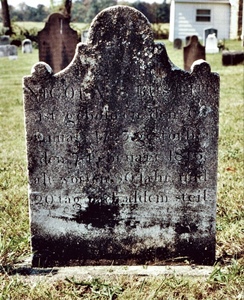 Nicolaus' original tombstone in Adams County. Photo by: Carl Foscht, © Copyright, all rights reserved.
|
|
The Colonial American Bushey family has been a successful line and there are numerous descendants. If Nicolaus, who is six years younger, is equated with the same generation as Andrew, then it's possible to understand just how successful. A check in the Bushongs United Tree, shows that Andrew had four sons, known to have had children and with same generation from Hans and Barbara Bushong, - Hans Philip, John, and Jacob, had 10 children, who passed on the surname is interesting. Nicholas Buschi, though not fully charted had 8 or 9 sons who procreated. This illustrates that the number of American Bushey descendants could be sizeable, and it could easily be as many as Hans and Barbara, with their 10 grandsons. And that's a lot of cousins for the Bushong family. However, not all Bushey are from this particular line. From Germany there were others, and though it's certainly possible they were related, lacking genealogy or any kind of chart, at this point, it can't be said. There are also the Bushey, of French and French Canadian lines, among others, and like the Buschi, their names were anglicized, being originally Booshey, Bouchard, or other.
Which bring us to another point. Even though genealogy, appears to connect the Buschi and the Bushong, from the present, it could be 10 to 12 generations back, to a most recent common ancestor. That's a long way back, and it still isn't absolutely certain that they are the same paternal line as Bushong. Even the church began listing Buschi, as early as the 1550s, in Oberwil i. S. Switzerland. So to bridge the centuries and the uncertainty, it would seem that this is exactly where science can help, and that's through DNA testing and analysis. In order to accomplish this, a new project has been established at Family Tree DNA, (FTDNA), for the surname Boschung and its variations, Buschon, Buschi, and Bushey, This project has a wider scope than the previous Bushong project that, without direction is merely churning redundant samples, from those they call "true blood Bushongs". And FTDNA is only too happy to do another test. The Boschung DNA Project will use a targeted approach, and will be completely public, and open, with the exception that participants' names will be replaced with FTDNA's kit numbers and the earliest known ancestor,s name.
|
Though still unpopulated with any data or completed tests, the FTDNA Boschung project can be seen here. However, there are many living descendants of the Buschi, and some have already been identified as direct descendants of Nicolaus. So the project is currently seeking Y-DNA from his line and men carrying the Buschi, Bushey, and Boschung surname. A 37 marker test (recommended) lists at $169, but go occasionally on sale. For this project, they can be ordered from FTDNA, here.
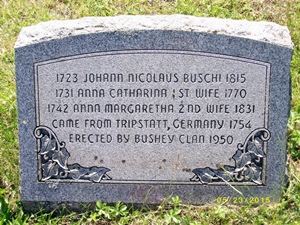
In 1950, the Bushey descendants erected this monument to Nicolaus
and the two Schmalenberger sisters, that were his wife.
Photo compliments of Frankie from FindaGrave. © Copyright, all rights reserved.
Are the Bushey Family descendants cousins with the Colonial Bushongs?
Rick
April 2, 2016
From Trippstadt, Germany
Vetting Uncle Andreas Buschon and the Cousins!
There is a country town called Trippstadt in the Kaiserslautern district of Rheinland-Pfalz, Germany. Never very large, and only having a population of 3,088 in a census taken in 2008, it is about four and one half miles (7.3 km), from Schmalenberg. It's Schmalenberg, where some of the Colonial American Bushongs, including Johann Nicholas Bushong and his son, Anthony Andrew, have been documented. Read about it here. However, it now seems likely, that sometime before 1660, a Boschung line made Trippstadt its home in Germany. Then within a few years, they are found in church records from towns and villages all around the area, including Geiselberg, Molscbach, Pirmasens, Schmalenberg, Schopp, Stelzenberg, Stüterhof, Walhaben, Waldfischbach, as well as others, (see map below). A search of Trippstadt church records, in the LDS, International Genealogy Index, (IGI), for various spellings of the Boschung surname, confirms this. These Boschungs have now been charted into the Bushong United Family Tree. If correct, they are descended from a Johann Andreas Buschon, who is an apparent son of Hans Boschung (I) and Anna Anneler. That would make him a great uncle to our Johann Nicholas Bushong the immigrant. Here's how the new Boschung line is charted in the Bushong United Tree...
|
Family Tree of Johann Andreas Boschung For Vetting
1 Michel Studer Boschung b: 1575 d: y
+ Dichtli Jaggi b: ABT 1580 d: y
2 Hans *vetting Boschung b: 18 JAN 1600 d: 11 JUN 1669
+ Anna Anneler b: 20 JUL 1609 d: 30 OCT 1690
3 Johann Andreas *vetting Boschung d: y
+ wife d: y
4 Maria Elisabeth Boschung d: 26 FEB 1729
4 Johannes Boschung b: 22 JUN 1661 d: 29 MAR 1744
+ wife d: y
5 Hans Jacob Boschung b: ABT 1684 d: 8 JAN 1746
+ Clara Elisabetha Huber b: 1697 d: 15 FEB 1748
6 Eva Marie Catherine Boschung b: 1718 d: y
+ Johann Theobald Schmalenberger b: 1715 d: 11 DEC 1747
6 Anna Catharina Boschung b: 1722 d: y
5 Eva Boschung b: 24 MAR 1706 d: 24 JUN 1744
+ Johann Peter Huber b: 30 SEP 1694 d: 9 APR 1758
4 Johann Peter Boschung d: 12 OCT 1749
4 Johann Jost Boschung d: 24 MAR 1727
4 Hans Jacob *vetting Boschung b: 1661 d: 13 MAR 1744
+ Maria Margaretha Sytz b: 1664 d: y
5 Johannes Jacob *vetting Boschung b: ABT 1691 d: 23 DEC 1729
+ Maria Susanna Eberle b: 1697 d: 6 APR 1720
6 Maria Elisabeth Boschung b: 3 MAR 1715 d: 2 MAY 1789
+ Johann Philip Huber b: 1708 d: 7 MAY 1793
6 Johann Peter Boschung b: 20 JUN 1717 d: 29 JUN 1743
6 Johann Theobaldt Boschung b: 21 MAY 1719 d: 8 MAR 1760
+ Eva Margaretha *vetting Linn b: 29 MAR 1703 d: 21 FEB 1786
6 Johann Michael Boschung b: 26 OCT 1721 d: y
+ Mariae Magdalenae Haenselin d: y
7 Johann Peter Boschung b: 1748 d: y
7 daughter Boschung b: 1745 d: 8 SEP 1745
6 Johann Casper Boschung b: 19 NOV 1724 d: y
6 Johann Henrich Boschung b: 26 MAY 1726
6 Johann Nicolaus Buschi b: 6 JAN 1723 d: 7 FEB 1813
+ Anna Catharina Schmalenberger b: 17 JUN 1731 d: 8 JUL 1770
7 Christian Daniel Bushey b: 4 OCT 1751 d: 12 SEP 1826
7 Johann Henrich Bushey b: 4 OCT 1753 d: 15 NOV 1829
7 Johann Michael Bushey b: AUG 1755 d: 10 NOV 1821
7 Rudolph Bushey b: ABT 1756 d: y
7 Nicolaus Bushey b: 1761 d: 20 MAY 1849
7 Wilhelm Bushey b: ABT 1762 d: y
7 Johannes Bushey b: 14 APR 1764 d: 1804
7 Maria Saloma Bushey b: 26 MAY 1765 d: y
7 Rebecca Bushey b: 20 APR 1767 d: y
7 Anna Margaretha Bushey b: 20 DEC 1768 c: 2 JUN 1769 d: 11 MAY 1845
7 Catherine Bushey b: 8 JUL 1770 d: y
+ Anna Margaret Schmalenberger b: 29 AUG 1742 d: 20 DEC 1831
7 Johann Jacob Bushey b: 1 SEP 1777 d: 22 JUN 1841
7 Anna Marie Bushey b: 10 AUG 1773 d: 28 JUN 1856
7 Anna Margaretha Bushey b: 29 SEP 1781 d: 11 MAY 1845
5 Johannes *vetting Boschung b: 1681 d: 3 SEP 1728
|
This chart is a preliminary identification and is published for the purpose of vetting. There will likely be changes. For instance, two, Hans Jacob Boschung, and Johannes Boschung have nearly identical birth and death dates, and they might well be the same person. Also one other disclaimer is necessary, for the sake of charting, the assumed original spelling of their surname has been included, but these Boschung ancestors' name is spelled differently in the church books, where the IGI, is mostly sourced. Apparently the church clerics often shortened or misspelled the name, as Buschong, Buschon, Buschi, Buschey, and others. These different spellings have been preserved in the tree, as alternate surnames, and they are also searchable. With the Trippstadt Boschung comes other associated surnames. They are charted: Burkhardt, Eberle, Haenselin, Huber, Jacobi, Linn, Roschi, Schmalenberger, Sytz, and Voltz.
It's church records, from the LDS, International Genealogy Index, (IGI), that make up this new branch of the Boschung Tree. So perhaps this is a good point to briefly discuss the IGI. The IGI has a wealth of good information if, you're a little discerning when looking through the records. The earlier European records for Germany and some of Switzerland, have been inputted by individuals, mostly from original church records. But there can be good and bad, and in the American IGI, the Bushong records are created with a lot family lore, for instance, Hans Bushong and Barbara Foltz. Though it's been proven her maiden name was not Foltz (or de Hageneau), there's dozens of entries for this, along with Jean Beauchamp and other incorrect lore. Still it's possible, at least in the Trippstadt area, to separate the transcriptions of actual records from lore, and as an example, dates. When looking at a date that says "about", or an exact date of birth, the exact date is usually from a church register. But a christening could be listed as a date of birth, which is close, except for Anabaptist or Mennonites. Since they deferred baptism for 12 or 13 years, it could really throw off the search, as happened in one case. Ultimately, the records from Trippstadt, aside from duplicates, appear overall reliable and accurate, but are thin on associations, with missing parents' names. That's where genealogy comes into play - charting, individuals from various records into one family tree. And unless it's just a couple of generations, it's only through charting that any sense can be made of a family's relationships and history.
But how did the name change so drastically, Boschung to Buschon or Buschi? First remember, that by the 17th century, even though surnames were firmly established, their spelling often remained in flux. But the Bushong's own Hans and Nicholas, managed to spell their surname correctly, and this is possibly because they didn't go to the Trippstadt parish, or at least there's no record. As such, some kept their original name and some eventually changed it. But imagine the church books, with the pastors and church clerics dutifully writing everyone's name, and perhaps using the same misspelling year after year. The slight spelling change of Bosch to Busch doesn't seem very significant and could have easily occurred from a cleric's interpretation of a more popular regional pronunciation. But for the suffix, it appears something else happened. With the suffix, the clerics translated the patronymic suffix, "ung", which means "descendants of" and used a different suffix, as in "i" and "on". There are many other patronymic suffixes "son", "y", "ing" "en" and "er" as in Studer and Schmalenberger, just to name a few. Most pretty much translate to, "descended of" or "from" or "of". So in this case, the cleric maintained what he saw as their family name, "descendants of the Bosch or Busch" and simply changed the suffix to something shorter. To the clerics, Buschi, though a different spelling, meant the same thing as Boschung.
|
|
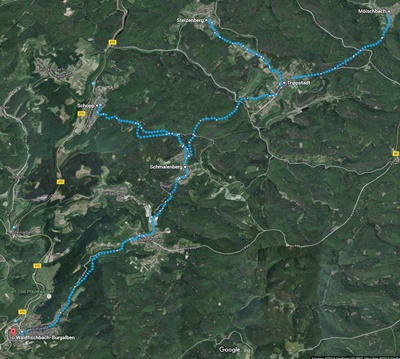 Trippstadt and some of the surrounding communities in the Rheinland-Pfalz, Germany, where the Boschung surname and its various spellings is recorded. Click to enlarge.
Map © Copyright Google Earth all rights reserved.
| |
It didn't happen right away, but over the years, through the generations of pastors and Boschungs. So, perhaps hearing the pastors pronouncing it, from the church books, as for instance, Buschi, the spelling became accepted. With a church full of people hearing something to the effect of "I now pronounce you Mr. and Mrs. Buschi, man and wife", it's easy to visualize the Trippstadt Boschungs as well as the townspeople, getting used to the different pronunciation. Further, the Dictionary of Alsatian Dialects says the surname Buschi is a ... "reference to Buschong",
here. And author Dietmar Meyer in his Waldfischbach area Church Book Transcriptions, (excerpt available in the Bushong Digital Library here) also references "Buschy" as an abbreviation for Buschong. There are others. Also, even the previously charted Bushong ancestor, Hans Boschung (II) 1600-1669, husband of Anna Anneler, is listed as Buschi by the church in the IGI.
But, regardless of spelling, the question should be asked, is Buschi the same family as the Trippstadt Buschon? And are they related to the Oberwil Boschungs, where much of the family came from? To answer, when all the cross-associations and intermarriages between the Swiss and Germany families, are considered it seems like they could be the same line. Especially between the Trippstadt Buschon, and Buschi, with the descendants of Hans Martin Huber, and the Schmalenberger families. All of these support Johann Andreas Buschon as the patriarch of this Trippstadt line. Here's a small chart for Hans Martin Huber. Notice the five different intermarriages between the Hubers, Schmalenbergers and the Buschong families.
1 Hans Martin Huber b: 18 NOV 1639 d: 1688
+ Katharina b: 1644 d: 1692
2 Johann Nicholas Huber b: 10 MAR 1667 d: 15 MAR 1718
+ Anna Catherine Linn b: 1671 d: 27 MAR 1711
2 Hans Bartholmaeus Huber b: ABT 1666 d: 24 JUL 1721
+ Anna Maria b: BEF 1666 d: 29 APR 1730
3 Clara Elisabetha Huber b: 1697 d: 15 FEB 1748
+ Hans Jacob Boschung b: ABT 1684 d: 8 JAN 1746
4 Eva Marie Catherine Boschung b: 1718 d: y
+ Johann Theobald Schmalenberger b: 1715 d: 11 DEC 1747
4 Anna Catharina Boschung b: 1722 d: y
3 Johann Peter Huber b: 30 SEP 1694 d: 9 APR 1758
+ Eva Boschung b: 24 MAR 1706 d: 24 JUN 1744
2 Maria Catharina Huber b: 27 FEB 1683 d: 23 SEP 1759
+ Johann Heinrich Schmalenberger b: 1683 d: 4 DEC 1754
3 Johann Theobald Schmalenberger b: 1715 d: 11 DEC 1747
+ Eva Marie Catherine Boschung b: 1718 d: y
2 Johann Philip Huber b: ABT 1675 d: 15 MAR 1718
+ Anna Katharina Burkhardt b: ABT 1683 d: Mae 22 1711
3 Johann Philip Huber b: 1708 d: 7 MAY 1793
+ Maria Elisabeth Boschung b: 3 MAR 1715 d: 2 MAY 1789
+ Eva Margaretha *vetting Linn b: 29 MAR 1703 d: 21 FEB 1786
2 Anna Margaretha Huber b: APR 1670 d: y
+ Johann Philip Schmalenberger b: 16 MAY 1680 d: 10 DEC 1755
3 Johann Philip Schmalenberger Jr. b: ABT 1700 d: y
3 Anna Katharina Schmalenberger b: ABT 1715 d: y |
But what about our own Nicholas Bushong? Is this Johann Andreas a great uncle? Or maybe it is a different line of Oberwil Boschung other than the Michael Studer-Boschung line - the Colonial Bushong line? There were after all, Boschung-Buschi in Oberwil in the 1550s, and it is just a logical assumption that Hans Boschung (II) and the Trippstadt Boschung patriarch are brothers. But based on that assumption, we can start finding inter-familial associations and use them to prove or disprove the relationship. Of course they share surnames and proximity, with Schmalenberg less than five miles from Trippstadt. And remember, as mentioned above, the IGI lists our own Hans Boschung (II) as Buschi. But there are two additional pieces of evidence. The first is thru Hans John Bushong (III), (the Pennsylvania immigrant before 1719). His sister Anna Boschung, married Michael Roschi in of Oberwil, i.S., Bern, Switzerland, March 7, 1693. Michael and Anna Boschung Roschi's son, Valentin, 1706-1752 and likely daughter, Veronica, 1706-1752 both moved to Trippstadt and married into the Schmalenberger family. Philip Roschi (Jr.) married Anna Katharina Schmalenberger, in 1732 and Veronica Roschi married Johann Philip Schmalenberger (Jr.). They are children of Johann Philip Schmalenberger, (1680-1755), (3rd from bottom of the chart above) and Anna Margaretha Huber. That means their descendants are both directly related to the Huber and Schmalenberger families that the Trippstadt Buschon-Buschi families married into. This represents a tangible link between the Boschung and Roschi of Oberwil, i.S., Bern, Switzerland to Trippstadt and to the Trippstadt Boschung, Buschon, and Buschi.
1 Michel Roschi b: 9 MAR 1662 d: 11 MAR 1706
+ Anna Boschung b: 1 AUG 1669 d: y
2 Veronica *vetting Roschi b: 1704 d: y
+ Johann Philip Schmalenberg b: ABT 1700 d: y
2 Valentin Roschi b: 3 MAY 1706 d: 6 APR 1752
+ Anna Katharina Schmalenberger b: ABT 1715 d: y
|
But the last piece of evidence is perhaps the most intriguing. In 1754, when Anthony Andrew Bushong, returned to America, from Europe, on the ship Recovery, he came with a Trippstadt cousin, Johann Nicolaus Buschi (Buskey on the ship's list). Listed in the top chart as Johann Nicolaus Buschi, (1723-1813), he would be our Andrew's third cousin. All of this seems to point to a Buschi-Boschung relationship, and in other words, it looks like the same family.
Another piece of the puzzle put together?
More details for every name mentioned above are available in the Bushong United Tree - here.
(opens in a new tab)
Rick
April 1, 2016
|
|
|
Bushong United is Copyright ©2017 by Rick
Bushong any Commercial Use is Prohibited.
Non-commercial use is allowed with permission or if
copyright is included.
Photos are in the commons or are otherwise noted. No Bandwidth Theft Allowed
|
|
|
|
|
